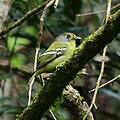|
Piprites
Piprites is a genus of bird currently placed in the family Tyrannidae. Prior to 1971, the genus was placed in the family Pipridae;[3] its designation was initially changed based on morphological evidence,[4] and genetic evidence confirmed its placement in 2009.[5] In 2013, it was proposed that Piprites was to be placed in the unique family Pipritinae.[1] The proposition was declined by the Comité de Clasificación de Sudamérica, a part of the American Ornithological Society, and the proposed family was changed to be a unique subfamily of the genus.[6] The genus is composed of three species native to the neotropical realm, with distributions ranging from the Caribbean coast of Guatemala, Central America, and southeastern Argentina.[7] EtymologyThe generic name Piprites is derived from the Greek πιπρα (pipra), meaning "small bird" and originally associated with the great spotted woodpecker and the various Neotropical manakins. The suffix ῑ́της (-ī́tēs) is also Greek and denotes "resembling" or "similar to", denoting the genus' similarity to the manakins.[8] SpeciesThe genus Piprites contains 3 species:[9]
References
External linksWikispecies has information related to Piprites. Wikimedia Commons has media related to Piprites. |
||||||||||||||||||||||||||||||||||||||||||||




